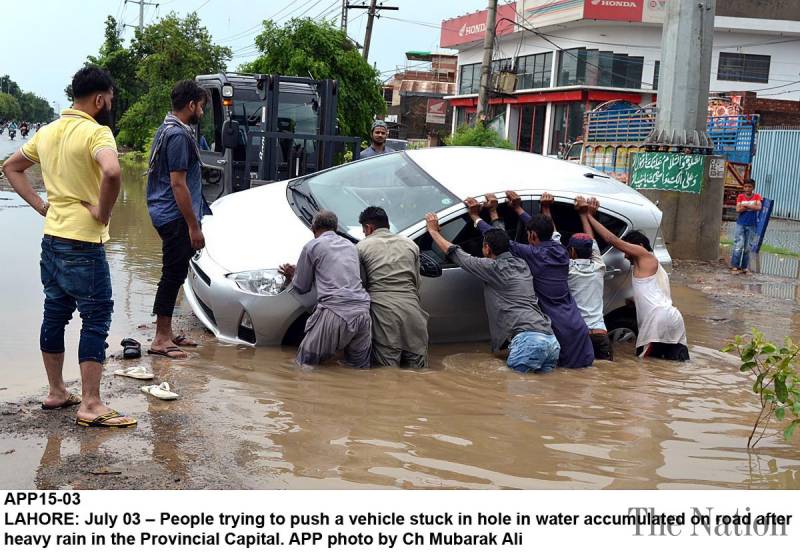News Desk |
Heavy rainfall in Lahore breaks record of the past 38 years, as stated by chief meteorologist of Pakistan, Muhammad Riaz.
This is so, as witnessed earlier that trying to fill in one sinkhole with landfill led to the creation of another. Water might seep down, and reach the core of these buildings.
Statistics show that this continuous 12-hour long rainfall prolongs further. Turning roads into virtual rivers, the massive rainfall in Lahore led to power failure, flood in residential areas as well as traffic congestion; as Mall Road gets a cavity right in front of the Lahore High Court.
Progressing since Monday night, 1st July, 2018, Lahore rainfalls have been predicted to continue for the next two days. Lahore recorded 214 millimeters i.e. 8.4 inches of rain in the 24 hours up to 8am on Tuesday.
Read more: Lahore: Mall road protest by Lady Health workers enters fifth day
Gruesome in nature, the impact of this rainfall led to man holes developing right in the middle of roads, near GPO (General Post Office) on Mall Road.
The area had been cordoned off and the traffic had been diverted from this route, causing a traffic disruption in the area.
Earlier during the day, flight operations at Allama Iqbal International Airport were also disrupted because of the heavy downpour. Four international flights scheduled to land at the airport were delayed and one flight had to change its course, landing early.
Various videos and images appeared on social media as soon as public witnessed two sinkholes develop right before their very eyes. These sink holes could be described as the ones; people may witness as an aftereffect of a massive earthquake.
No casualties had been reported near these man holes, however in other areas of Lahore due to the monsoon rainfall, six people had been reported of losing their lives and several injured. Four people died of electric shock while two others were killed after a building collapsed.
“Operations are being mounted across Lahore,” a Rescue 1122 spokesperson stated.
The sink holes were approximately 20ft deep and 200ft wide and 50ft appearing from a distance. This thunder wave led to WASA declaring a rain emergency across the city.
Gruesome in nature, the impact of this rainfall led to man holes developing right in the middle of roads, near GPO (General Post Office) on Mall Road.
Attracted many eyes, this massive sinkhole caused people to question the state of the management system of the country. People started blaming the planning and management of the government for this sinkhole appearance.
In several other countries sinkholes have developed in the past due to natural order. However, in order to prevent these sinkholes from developing ever again, the sewage system needs to be paid attention to.
Read more: Authorities look to revive past glory of Lahore
Twitter was flooded with tweets as people displayed their disapproval of the actions of the government.
Journalist Salman Masood @salmanmasood tweeted how the after effects of this rainfall may lead to a negative impact for some people, during the upcoming elections.
“Rain causing craters and holes in Lahore’s otherwise spanking new looking roads couldn’t have come at a worse time for PML-N in terms of election perception. The potholes are both literal and figurative”- He stated.
Another display of dissatisfaction was at the hands of interim minister as he stated, “Those responsible for Lahore sinkhole will be punished”.
In order to resolve this issue and investigate its root cause, a committee had been formed. According to the minister, the committee has been advised to submit its findings on the GPO Chowk sinkhole in a report within the next 48 hours since its formation.
As observed and reported by many, this seepage poses a threat to building like GPO Chowk and Lahore High Court. This is so, as witnessed earlier that trying to fill in one sinkhole with landfill led to the creation of another. Water might seep down, and reach the core of these buildings.
There isn’t just a need of an advisory committee, in fact the situation at hand demands implementation of actions of resolving the sewage problem which has ultimately led to the creation of such sinkholes.














